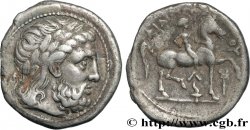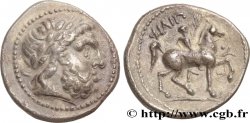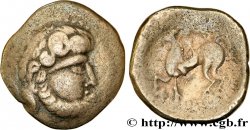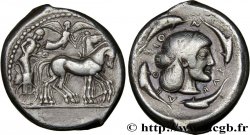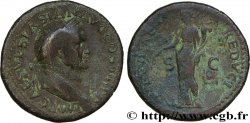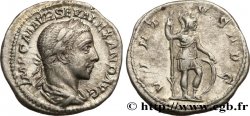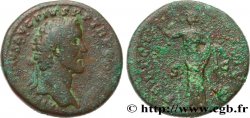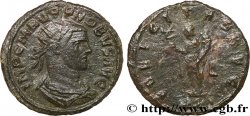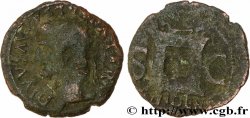v32_0959 - CELTI DEL DANUVIO Tétradrachme “au rameau”
MONNAIES 32 (2007)
Prezzo di inizio : 380.00 €
Valutazione : 600.00 €
lotto invenduto
Prezzo di inizio : 380.00 €
Valutazione : 600.00 €
lotto invenduto
Tipo : Tétradrachme “au rameau”
Data: (IIe-Ier siècles avant J.-C.)
Metallo : argento
Diametro : 25,6 mm
Asse di coniazione : 9 h.
Peso : 13,72 g.
Grado di rarità : R2
Commenti sullo stato di conservazione:
Bon exemplaire, complet et homogène, avec une patine grise et brillante. On devine un défaut de métal ou une contremarque sur le portrait
N° nelle opere di riferimento :
Diritto
Titolatura diritto : ANÉPIGRAPHE.
Descrittivo diritto : Tête laurée de Zeus à droite ; grènetis.
Rovescio
Descrittivo rovescio : Cavalier au pas à droite, tenant une palme de la main droite ; le cheval lève l'antérieur à droite ; entre les jambes du cheval, une torche.
Legenda rovescio : FILIP - POU
Commento
Si le statère d’or de Philippe II de Macédoine a servi de prototype à de nombreuses imitations gauloises, le tétradrachme n’a pas été imité en Gaule, mais reste principal sujet d’inspiration des monnaies pour les Celtes du Danube (LT. 9697-9767, 9768-9832, 9618-9630, 9870-9886). Les premières imitations furent frappées dans le premier quart du IIIe siècle avant J.-C. La fabrication des copies serviles, puis des imitations, enfin des frappes celtiques continuèrent pendant plus de deux siècles.
Au revers la torche correspond à Philippe III pour Amphipolis entre 323 et 316.
While the gold stater of Philip II of Macedon served as a prototype for many Gallic imitations, the tetradrachm was not imitated in Gaul, but remained the main source of inspiration for coins for the Danube Celts (LT. 9697-9767, 9768-9832, 9618-9630, 9870-9886). The first imitations were struck in the first quarter of the 3rd century BC. The manufacture of servile copies, then imitations, and finally Celtic strikes continued for more than two centuries. On the reverse, the torch corresponds to Philip III for Amphipolis between 323 and 316
Au revers la torche correspond à Philippe III pour Amphipolis entre 323 et 316.
While the gold stater of Philip II of Macedon served as a prototype for many Gallic imitations, the tetradrachm was not imitated in Gaul, but remained the main source of inspiration for coins for the Danube Celts (LT. 9697-9767, 9768-9832, 9618-9630, 9870-9886). The first imitations were struck in the first quarter of the 3rd century BC. The manufacture of servile copies, then imitations, and finally Celtic strikes continued for more than two centuries. On the reverse, the torch corresponds to Philip III for Amphipolis between 323 and 316








 Segnalare un errore
Segnalare un errore Stampate la pagina
Stampate la pagina Condividi mia selezione
Condividi mia selezione Fai una domanda
Fai una domanda Consegnare / vendere
Consegnare / vendere
 Descrittivo
Descrittivo
